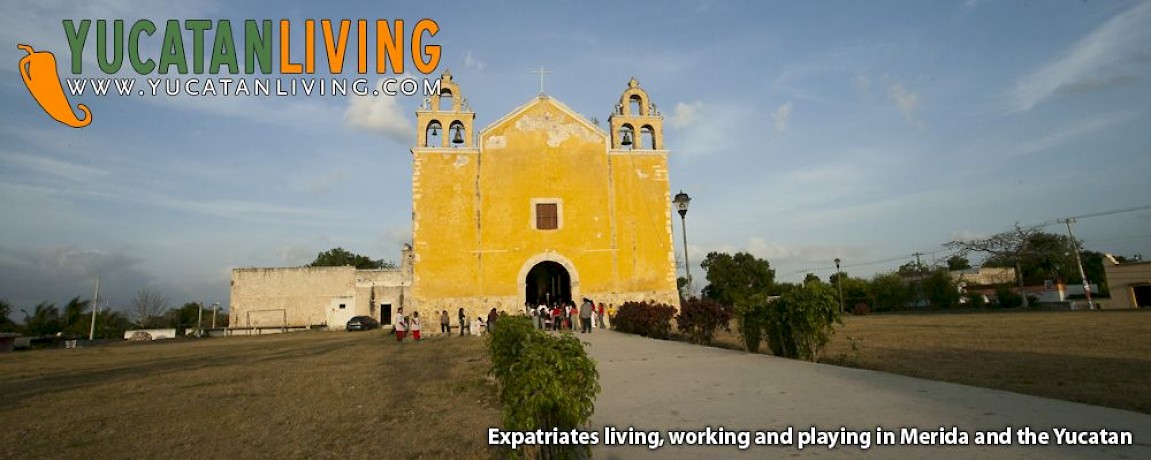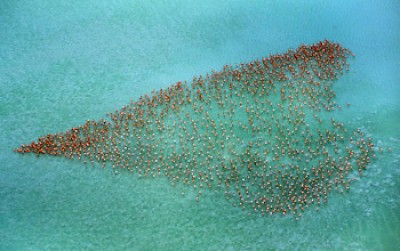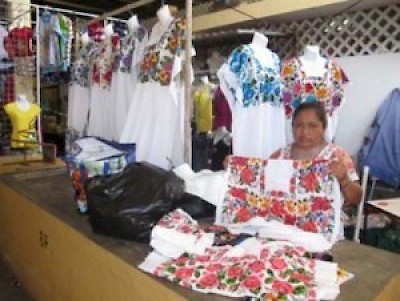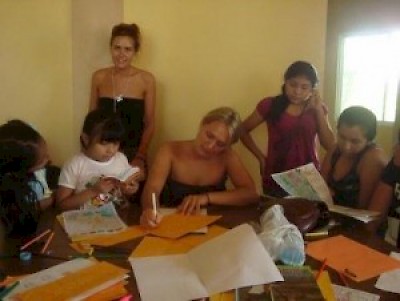Yucatan News: Peon Contreras Remodel
July 23, 2012
We “heart” Yucatan Too!
A photo by German photographer Klaus Nigge has been all the rage this week, and has even made it into Huffington Post. It seems that Mr. Nigge was following a flock of flamingos over Yucatan and was lucky enough to capture them flying in the formation of a heart. You can visit more of Klaus Nigge’s Yucatan flamingo photos in an album on National Georgaphic’s website.
More: Wet and Windy
With the fifth tropical wave this year having now come through the peninsula, Yucatan is once more wet and windy. In fact, it’s wet and windy all the way from Campeche to Guatemala. Winds that reached 100 kilometers per hour in Campeche fell to 60 kilometers per hour in Merida, but that was still enough to remind everyone that it really is time to prepare for a hurricane, just in case. You can find a Guide to Protection, Bulletins, a list of Temporary Shelters, satellite images, emergency numbers, and much more on the website of Yucatan’s Civil Protection (PROCIVY).
Teatro Peon Contreras Remodeling
If you have been by Teatro Peon Contreras in the past day or two, you probably noticed the workmen. They are on a 45-day blitz to put in new seating, including seating for those who are disabled, and to upgrade the bathrooms. Each year, it seems that Teatro Peon Contreras gets some sort of major remodel but seating and bathrooms never quite got to the top of the list. All of a sudden, everyone realized it had been over 30 years since the seats had been replaced. Now, with new seating and increased capacity, this grand lady of a building can continue to serve Merida and her guests with pride. Teatro Peon Contreras will reopen in early September, if all goes as planned. And the citizens of Merida can continue to enjoy ever-increasing quality performances in a opera house that rivals those in Europe!
Shoes: Hurry to Ticul!
There is a ten-day festival going on in Ticul, in honor of the 145th anniversary of the city and they’ve got an extra shoe fair as part of it! Local producers are also selling pottery. The opening was a little slow because of the weather, so there should be plenty of great buys left when you get there. This shoe and pottery fair is one of the most important money-makers for producers in the southern cone of Yucatan, and they have begun to change the theme of what they are showing and selling with each new fair. Throughout this fair, shoes and pottery can be found at the Plaza de la Cultura, Calle 26 x 23 y 25, in Ticul.
Domestic Tourism: Both Sides of the Coin
What a thrill it is to see tour buses rolling, one after another, full of domestic tourists from all parts of Mexico. That means that there is enough extra money in the pockets of ordinary, middle-class, Mexican citizens to take that long-awaited vacation to some of the world-famous destinations in their own backyards. So why no smile on the faces of the artisans in places like Valladolid? Tourism numbers are up and they should be grinning from ear to ear. Evidently, there is quite a bit of difference between domestic and foreign tourism, and an obstacle to profit that is in need of a workaround. In Valladolid, international tourists who stay the night spend an average of $3,000 pesos per person, while domestic tourists, just passing through on tours, spend only an average of $700 pesos per person. When a seller pays $180 pesos for an item and only sells it for $200 pesos, it takes a whole lot of domestic tourists to make a living for the vendors. Also, domestic tourists are not stopping in places like Valladolid to spend the night. Instead, they are usually stopping in the middle of the day, as they travel between Merida and some destination on the coast of Quintana Roo. In this case, it has now been determined that domestic tourists, who do not spend the night, do not increase the overall economy of stopping points between destinations. It will be interesting to watch what some of our wonderful pass-through towns do with this information and how they go about making their towns over into premier destination cities.
Beef Prices on the Rise in Yucatan
With no prior warning, the butchers in the municipal market in Uman raised the price of a kilo of beef by 33% to 50%. This meant that some prices rose from $60 pesos per kilo to $80 pesos per kilo and, in come cases, $90 pesos per kilo. In Merida, ground beef rose from $44.90 pesos per kilo ($1.55 per lb) to $46 pesos per kilo ($1.58 per lb), while Milanese beef (thinly sliced steak) prices rose from $79 pesos per kilo ($2.72 per lb) to $112.90 pesos per kilo ($3.88 per lb). While many expats continue to view those as very low prices, the average salaried person in Yucatan views it quite differently, as do the beef producers, who must endure rising costs associated with every aspect of bringing cattle to market. Everyone will be watching to see how Yucatecos rise, once again, to meet difficult circumstances head on.
August: Young Children Release Baby Turtles
We have honestly got one of the cutest traditions in the whole world right here in Yucatan. Every August, when the beaches of Yucatan are crowded with tourists and vacationers, young children in Yucatan go to work. You see, adults don’t release baby turtles in Yucatan…only young children do that. These are baby turtles that have hatched under the protection of the Conservation of Priority Species Department of the Ministry of the Environment and Urban Development. These events, of course, result in really just too cute photos in all of the newspapers. Plus, if you are in Yucatan in August, you can go and watch these events. There are regular dates listed, but you need to get in touch with those in charge first because much of what happens depends on when the eggs actually hatch. With 195 nests waiting to hatch, we think this is a great year to watch this event! The dates they now plan on releasing baby turtles include: July 28 and 29, and August 4 and 5, 11 and 12, and 18 and 19. To attend any of these events, and to be notified of changes, e-mail: Luis Mendez (luis.Mendez@yucatan.gob.mx ) and/or Raul Miranda (raul.Miranda@yucatan.gob.mx ) indicating the date you would like to attend and the attendees in your group. If you can’t make it this year, mark your calendar for all weekends in August 2013. This is an annual event!
Pulpo Season Begins August 1
Fishing for pulpo (octopus) is the harvest that contributes the greatest amount of money for fishermen in Yucatan. This is the money that will put their children in school for the next year. This is the money that will provide for Christmas for the family, as well as providing for basic necessities and food on their tables. This is also the season in which several will, undoubtedly, lose their lives. Quite naturally, pulpo fishermen are now pushing for a census of all pulpo boats because they have noticed boats from other places literally hiding in plain site among their boats in Sisal. The census will take place this week and interlopers will be given 72 hours to take their boats back where they came from. We wish every pulpo fisherman great success this year! They have worked hard and sacrificed much to conserve pulpo along the coast of Yucatan. They deserve well wishes and good luck as they begin yet another pulpo season in Yucatan.
Rosalía Uicab Ek: Xocbichuy
For twenty years, Rosalía Uicab Ek has been doing counted thread embroidery (also known as xocbichuy) on huipiles. She never participates in craft fairs because they would take too much time away from work. Her huipiles are carried by travel agencies, and at outlets at Chichen Itza and in Cancun. However, for the most part, she sells her work from Calle 35 #211-A x 30 y 32, in Hunucma. It takes six months to complete a huipil embroidered by hand and we had to really sit and think about the fact that these works of art are then sold for only $2,000 to $2,300 pesos (about $150 USD). While Rosalía Uicab Ek works at her craft for the love of her art, we suggest that the purchase of one of her pieces, plus a nice tip, might be a great way to start out someone’s Christmas shopping list for this year. There are artisans like Rosalía Uicab Ek all over Yucatan. We hope that everyone will seek them out and purchase their fine work whenever they can. This is the best way to keep many of the traditions of the Yucatan we all love alive and well far into the future.
Gap Year English Girls in Hunucma
There is a wonderful group of young English ladies volunteering to teach physical education, dance and English to children in Hunucma. No – they don’t speak Spanish but, after only a week, they love the children and the children love them too! These young ladies belong to a volunteer organization called Original Volunteering, and, after reading just that one web page, we are absolutely sold on the idea. Every young person should take a gap year off and volunteer somewhere in the world! Not only will these young ladies leave their mark forever on the children of Hunucma, but we are certain that this experience will help to mold the volunteers into the kind of human beings that are so desperately needed in the world today. Its wonderful to know they are here and we are sure they’ll always come back to Yucatan.













Comments
Khaki Scott 13 years ago
Iris - I read the photographer's own comment about that flaminto heart formation picture. He was as surprised as anybody when he realized he had it. He said that, if he had known it, he would have had the pilot make another round or two so he could get more. So that photo actually was a Gift from Mother Nature herself!
Reply
Jose Aaron Herrera Villanueva 13 years ago
I am anxiously awaiting the new opening of the Peon Contreras Theater. We, here in Merida, feel very proud to have a world class modern building such as the Peon Contreras.!
Reply
Iris 13 years ago
Cristo move over! The beauty of The Flamingo photos is that the artist noticed! So many of us would have missed it.
Reply
(0 to 3 comments)